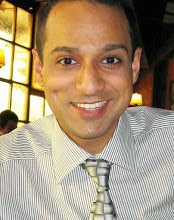MyZeil Street: Copyright Navjot Singh
I had the pleasure of going to Frankfurt on the kind invitation of the Frankfurt Tourism Board. This was my first time to Germany. What are my initial thoughts? Anyone can say that they like a place or they love the food, but one of the sweetest things I noticed in Germany is the kindness and friendliness of the Germany people. German people are the friendliest and nicest people I have met so far on my travels. I mean this from my heart and not just saying this because I was on a press trip. There are so many examples to choose from. One was in a cafe in downtown Frankfurt. I got my meal and drink, but could not find a seat to dine at- as almost all the seats were full and the two that were empty, were actually reserved. I was surprised to say that not one but at least four people (at four different tables) offered me to sit next to them at their table. In UK or other European countries (or even in Asia) that I have been to normally you may get the odd nice person offering a complete stranger to share the table with them. But in Germany I noticed that this is not just one person but almost everyone is naturally friendly towards strangers. I did not have any badge or the slightest hint that I may be an official photographer or journalist (well, it was obvious that I at least looked like a tourist with a camera!). Even if one is somewhat lost and asks someone for directions, then people will direct you in the correct way- they will take time to even walk with you towards the correct path until you are sure you know where you are heading to. In some other parts of the world, I found that people just maybe do not have the time, or because in bigger cities such as Paris and London, people are too wary of approaching strangers. It’s always that case of "if he gets in trouble, I don’t want to be dragged into it too", and so on. But am I being too favourable to Frankfurters? Certainly not, it’s the truth and straightforward viewpoint. Although maybe this is because of the internationalism of the city- around 60 percent of the inhabitants are from outside of Germany- mostly students and business people alike. This tends to provide an exciting mix of the old and new, as well as the glamorous and un-glamorous. There is also the certain contrast of being in a part of the city that feels like a village as opposed to another part that feels like a seriously active metropolis. The suburbs are not too far out, walk for around 30 minutes in one direction outside of the CBD (Central Business District) and you will come across parts of the city which are remarkably silent.

Want some German Snacks? Copyright Navjot Singh
Apart from the friendly people, I found Frankfurt to be a much smaller place than I had imagined. It’s nicknamed the “Mainhattan” in regards to its resemblance to Manhattan, although on a much smaller scale- which is without a doubt quite sweet. It is after all a global financial hub, and so with 500 of the world’s banks’ firmly located in the city it does sound like a very giant city (in terms of importance it is), whereas in actual fact you can easily walk from one side of the city centre to the other in around 40 minutes (or less if you walk fast).
London or Frankfurt? Copyright Navjot Singh
Frankfurt airport forms a vital part of the city and Frankfurters are very much proud of their airport for quite a number of reasons. Two of the main reasons are that it is the largest single employer in the whole of Germany with over 70,000 people contributing to its existence and growth, and the secondly that Frankfurt is the hub for many of the world’s airlines- both passenger and cargo. For many American and Asian carriers, Frankfurt is a second hub away from their homebase. Before the collapse of Pan Am airways in the early 1990s, Frankfurt was their man European base, and nowadays Air India has its base at Frankfurt airport too.
A "Beer Bike" in Frankfurt: Copyright Navjot Singh
I found Frankfurt to be quite an old fashioned, laid back city, very much similar to, say, Geneva (although on a much larger scale).It is also dubbed the city of museums, and it’s not hard to find out why because they are everywhere! Schaumainkai is famous for some of the most renowned museums in the whole of Germany. The street lies on the banks of the river Main, with a fascinating view across to the metropolis on the other side, and is home to 13 museums. Frankfurt has a rich Jewish history, and the roots of many Jewish people around the world actually derive from the very roads which I had the chance to walk upon. Jewish history forms the vital essence to the existence of the vast majority of the museums in Frankfurt, which are a perfect model for preserving culture and heritage. Some of the renowned museums include:
Wired Sheep greet visitors at the Communications Museum: Copyright Navjot Singh
The
Communications Museum, which showcases the rich history of Telecommunication in Germany, right from the beginnings, can make any young explorer turn into a kid in a candy shop. Rather interestingly you’ll be greeted by a flock of sheep made up from nothing but long telephone wires and telephone headsets- not really sure what to say on that one except that its interesting. You’ll need around one to two hours to fully enjoy the displays.
It's all posh at the MD Bar: Copyright Navjot Singh
Founded in 1979, the
German Architecture Museum (
http://www.dam-online.com/), which is just a couple of doors down the road, is also a fascinating place to while away your time. It’s the only museum of its kind in Europe that displays such exquisite artefacts of significance.
The
Stadel (
http://www.staedelmuseum.de/), which is situated directly on the bank of the river Main (like most of the other museums), is known to be one of the oldest and most significant museum foundations in Germany. Here you will be greeted to art collections that span a total of seven centuries. Allow around 1 to two hours to enjoy the full ambience of the place.
Sight-seeing Frankfurt style: Copyright Navjot Singh
Frankfurters are also very proud of
Johann Wolfgang Von Goethe (28 August 1749 – 22 March 1832), the great Poet, Artist, Musician...and quite essentially a jack of all trades, and a master of all too! He had quite an influence on many people with responsibility and with that charm and influence he gained many people’s respect. Goethe was one of the key figures of German literature and the movement of Weimar Classicism in the late 18th and early 19th centuries. If I am honest, in actual fact in my younger years I, like many other younger people (i.e. teenagers etc.), used to find art and classical music rather boring and almost meaningless really. Effectively, yes, museums can be rather boring, but the main turning point for me to make them interesting was my love for photography- pictures can make even the most unattractive article look pleasing.
A must visit place is the
Goethe House in the old part of Frankfurt (
http://www.goethehaus-frankfurt.de/), which until 1795 was the residence of the Goethe family. Everything inside including the furniture, the utensils’, the artworks (most of them by Goethe himself), and the furnishings are preserved immaculately. He spent much of his early years here, and many artifacts in the home are in relation to his lavish childhood.
Recommended Restaurants/Cafes:
German cuisine is a stark contrast of two...the sweet (very sweet!) and sour (or spicy to be extent) - one may even go ahead and say that this can be classed essentially as healthy and non-healthy. In almost every cafe, restaurant and bar you go to, you’ll be greeted by a myriad of richly decorated fancy cakes and deserts, as well as drinks (German Beer is like no other- and the glasses are huge to!). Then there is a healthy part of the food which contains lots of fresh salad, lentils and vegetables. I guess the genuine idea is to have a full bowl of something very healthy and then polish it all up with a plate of your favourite Apple or Rhubarb crumble.
For traditional German cuisine (Including Apple Wine) it has to be the
Zum Gemaltenhaus at Schweizer Str. 67 (
http://www.zumgemaltenhaus.com/)
For a traditional German cafe, then go to the
Cafe Hauptwache (
http://www.cfe-hauptwache.de/) or Cafe Liebfrauenberg at Liebfrauenberg 24.
For a Japanese meal, head to the
Aiso Restaurant (
aiso.asiagourmet.de) at the MyZeil Shopping Centre in downtown Frankfurt.
For breakfast, I would highly recommend
Cafe Wacker (
http://www.wackers-kaffee.de/) . It’s one of the oldest cafes in Frankfurt, although operating since 1914, the cafe was originally thought t o have been the place where one of the oldest sons of Frankfurt, J.W. Von Goethe, was rumoured to have bought milk everyday! Why not try a homemade carrot cake with some freshly made coffee? The staff members speak English and German. The prices are reasonable.
Where I stayed?
Steigenberger Frankfurter Hof*****
Am Kaiserplatz
60311 Frankfurt am Main
Deutschland
Tel: +49 69 215-02
Fax: +49 69 215-900
Website:
http://www.steigenberger.com/Frankfurt
How I got there?
Lufthansa German Airlines
http://www.lufthansa.com/ from London Heathrow to Frankfurt Main.
How I got around the city?
The Frankfurt Card is a useful way to explore Frankfurt. It can be purchased from any metro station, at the airport or even at most convenience stores dotted around the city.
More photos are available at
http://www.navjot-singh.com/





























































